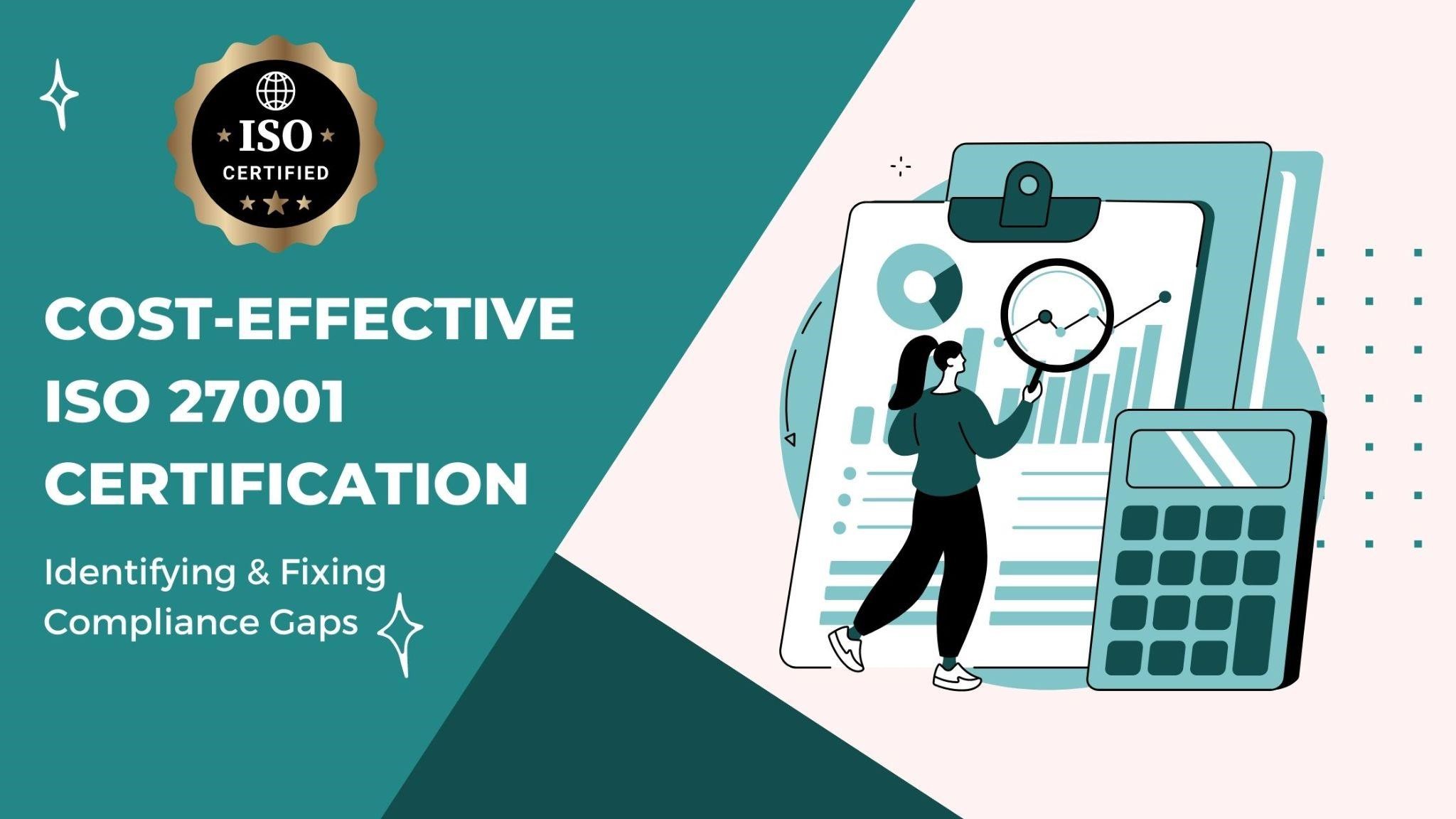Cost Effective ISO 27001 Certification Identifying Fixing Compliance Gaps

ISO 27001 is a globally acknowledged standard developed by the International Organization for Standardization [ISO] to address information security risks & vulnerabilities. It sets forth a systematic approach to identify, manage & mitigate information security risks, providing organisations with the tools needed to safeguard their valuable assets, including sensitive data & intellectual property.
The standard’s importance for information security cannot be overstated. It serves as a comprehensive blueprint that assists organisations in designing & implementing an Information Security Management System [ISMS]. Through the adoption of ISO 27001, organisations can define clear security objectives, establish robust policies & procedures & create a framework for continuous improvement in their security practices.
While the benefits of ISO 27001 are undeniable, the road to implementation can often be perceived as daunting, particularly in terms of cost. For organisations, especially small & medium-sized enterprises, the financial resources required to achieve compliance may seem overwhelming. However, understanding the significance of cost-effectiveness in this context can transform this perception.
Understanding ISO 27001 Compliance:
At its core, ISO 27001 aims to protect an organisation’s valuable information assets from a wide array of threats, both internal & external. These assets include critical data, intellectual property, customer information & sensitive business processes. The standard fosters a proactive approach to identifying & mitigating risks, ensuring that information remains confidential, available & unaltered when needed. The primary objectives of ISO 27001 revolve around:
- Risk Management: ISO 27001 compels organisations to conduct a thorough risk assessment, identifying potential vulnerabilities & threats to information security. By understanding the risks, organisations can develop appropriate controls to manage & minimise these risks effectively.
- Legal & Regulatory Compliance: Compliance with relevant laws & regulations is critical to maintaining the trust of stakeholders & customers. ISO 27001 ensures that organisations establish a robust framework to meet these obligations concerning information security.
- Continual Improvement: ISO 27001 promotes a culture of continual improvement in information security practices. By regularly reviewing & updating the ISMS, organisations can stay ahead of emerging threats & adapt to changing business environments.
ISO 27001 compliance is a multi-dimensional process that encompasses several key requirements. These requirements are designed to address the specific challenges of information security & contribute to building a secure organisation.
- Risk Assessment & Management: One of the fundamental pillars of ISO 27001 is conducting a comprehensive risk assessment. This involves identifying assets, evaluating vulnerabilities, analysing threats & determining the potential impact of security incidents. By understanding these factors, organisations can prioritise their security efforts & allocate resources effectively to protect their most critical assets.
- Information Security Policies: ISO 27001 mandates the development of clear & comprehensive Information Security Policies. These policies act as guidelines for employees, outlining acceptable security practices & ensuring a consistent approach to information protection across the organisation.
- Access Control: Controlling access to sensitive information is vital in preventing unauthorised access & data breaches. ISO 27001 requires organisations to implement stringent access control measures, such as role-based access & authentication protocols, to safeguard their data.
- Incident Response & Management: Despite the best preventive measures, security incidents can occur. ISO 27001 stipulates the establishment of an effective incident response plan to promptly address & mitigate the impact of security breaches.
- Training & Awareness: Human error remains one of the most significant contributors to security incidents. ISO 27001 emphasises the importance of ongoing training & awareness programs to educate employees about security best practices & the risks associated with their actions.
While the benefits of ISO 27001 compliance are undeniable, organisations encounter several challenges in their journey towards achieving & maintaining compliance.
The Cost Factor in ISO 27001 Implementation:
ISO 27001 adoption involves a range of financial implications that can vary significantly based on an organisation’s size, complexity & industry. Larger enterprises with sprawling IT infrastructures & numerous departments may incur higher initial costs due to the scale of implementation & the need for extensive security measures. On the other hand, smaller organisations may face comparatively lower upfront expenses but might encounter challenges in dedicating adequate resources to ensure compliance.
The industry in which an organisation operates also plays a crucial role in determining the financial impact of ISO 27001 adoption. For example, businesses in highly regulated sectors such as finance or healthcare may face additional compliance requirements, leading to increased implementation costs. Conversely, industries with relatively lower data security risks might find their initial investment more manageable.
Regardless of size or industry, the financial implications of ISO 27001 adoption should be seen as an investment rather than an expense. By aligning information security practices with the ISO 27001 standard, organisations can avoid potential financial losses resulting from data breaches, cyber-attacks & regulatory fines.
Cost-effectiveness in ISO 27001 implementation centres around striking the right balance between the financial resources invested & the value derived from the security measures adopted. It does not imply compromising on security but rather tailoring the implementation process to meet an organisation’s specific needs & budgetary constraints. Organisations can achieve cost-effectiveness by conducting a thorough risk assessment to identify & prioritise the most critical security gaps. By focusing resources on high-impact areas, they can address vulnerabilities efficiently & allocate resources where they are most needed.
Another aspect of cost-effectiveness involves leveraging existing technologies & infrastructure whenever possible. Integrating ISO 27001 compliance into existing processes & systems reduces the need for significant investments in new tools & technologies. Moreover, organisations can explore outsourcing certain aspects of ISO 27001 compliance to specialised service providers. This can be a more economical approach for smaller businesses that may not have the in-house expertise to handle all aspects of compliance.
Identifying Compliance Gaps:
At the core of achieving robust ISO 27001 compliance lies a comprehensive risk assessment. This process is akin to peering into the organisation’s information security landscape, uncovering potential vulnerabilities & understanding the lurking threats. A well-executed risk assessment empowers organisations to identify compliance gaps effectively, providing the necessary insights to build targeted mitigation strategies. ISO 27001 compliance is not without its challenges & organisations frequently encounter common areas where they may fall short of full compliance. These areas often revolve around three key aspects:
- Documentation: Maintaining comprehensive & up-to-date documentation is crucial for ISO 27001 compliance. Organisations may struggle to document their information security policies, procedures & controls adequately. Incomplete or inconsistent documentation can lead to compliance gaps.
- Access Control: Properly managing access to sensitive information is an area where many organisations face challenges. Deficiencies in authentication mechanisms, inadequate role-based access control or lax password policies can create compliance gaps, exposing the organisation to security risks.
- Incident Response: Having a robust incident response plan is critical in promptly addressing security incidents & mitigating their impact. Organisations that lack well-defined response procedures or fail to regularly test & update their plans are at risk of compliance gaps in this area.
To ensure a thorough gap analysis, organisations can leverage both internal & external resources. Internal resources, such as the organisation’s information security team & IT professionals, possess in-depth knowledge of the organisation’s infrastructure & operations. They can provide valuable insights into potential compliance gaps specific to the organisation’s unique environment.
External resources, such as specialised consultants & auditors, bring a fresh perspective & expertise to the table. They have extensive experience in ISO 27001 compliance & can offer an unbiased assessment of the organisation’s information security practices. Engaging external resources for independent audits & reviews can lead to more comprehensive gap analyses, identifying blind spots that might be overlooked internally.
Prioritising Compliance Gaps:
Not all compliance gaps are created equal & understanding the varying degrees of severity is important in maintaining a robust information security posture. Some gaps may pose a minimal risk, while others could potentially lead to significant data breaches or financial losses. By discerning the severity of each gap, organisations can allocate resources judiciously & tackle the most critical issues first. Severity assessment considers factors such as the impact of a potential breach, the likelihood of occurrence & the extent to which the gap deviates from ISO 27001 requirements.
To implement a risk-based approach, organisations assign a risk level to each compliance gap, taking into account the likelihood of occurrence & the severity of potential consequences. The highest risk gaps are deemed the most critical & demand immediate attention, while lower risk gaps may be addressed through more measured, long-term strategies. Prioritising compliance gaps not only enhances information security but also ensures the efficient allocation of resources. Given that resources, both financial & human, are finite, it becomes imperative to concentrate efforts where they can yield the most significant impact.
By addressing critical gaps first, organisations can significantly reduce the likelihood of experiencing major security incidents & the resulting financial implications. Moreover, early resolution of high-priority gaps bolsters the organisation’s overall security posture, making it more resilient against potential threats.
Cost-Effective Solutions for Compliance:
By conducting a thorough assessment of an organisation’s risk profile & understanding its operational environment, stakeholders can identify the most critical security gaps that require immediate attention. This targeted approach ensures that resources are allocated where they are needed most, avoiding unnecessary expenses on areas with lower risk or lower impact.
Tailored solutions also involve leveraging existing expertise within the organisation. Nurturing internal talent & providing adequate training equips employees with the skills required for maintaining compliance, reducing the reliance on external consultants & costs associated with outsourcing every aspect of compliance.
There is also a growing range of cost-effective tools & technologies available to aid organisations in achieving ISO 27001 compliance without breaking the bank. Automation tools, for example, streamline routine tasks such as vulnerability scanning, access control management & incident response. By reducing manual intervention, these tools not only enhance efficiency but also minimise the potential for human error, which can be a significant source of compliance gaps.
Furthermore, cloud-based solutions provide a flexible & scalable approach to meeting compliance requirements. Cloud service providers typically offer various security features & controls that can be readily incorporated into an organisation’s ISMS. The pay-as-you-go model of cloud services also allows organisations to adjust their usage & expenses based on their actual needs, ensuring cost-effectiveness.
Outsourcing certain aspects of ISO 27001 compliance can also prove cost-effective. Engaging third-party experts for tasks such as risk assessments, penetration testing & security audits allows organisations to tap into specialised knowledge without maintaining full-time security staff. This approach not only saves on hiring & training costs but also provides access to experienced professionals who can expedite compliance efforts.
Conclusion:
Addressing compliance gaps efficiently also means leveraging tailored solutions that fit an organisation’s specific needs & budget constraints. Rather than adopting a one-size-fits-all approach, organisations should consider their unique risk profile & operational environment, ensuring that security measures are both effective & cost-efficient.
Maintaining ISO 27001 compliance is not merely a box-ticking exercise; it is an enduring commitment to robust information security & risk management. The benefits of ISO 27001 extend far beyond the initial investment, delivering long-term advantages for organisations. By achieving & sustaining ISO 27001 compliance, organisations build a reputation for trust & credibility among clients, partners & stakeholders. Demonstrating a commitment to information security instils confidence, setting organisations apart in an increasingly competitive market.






